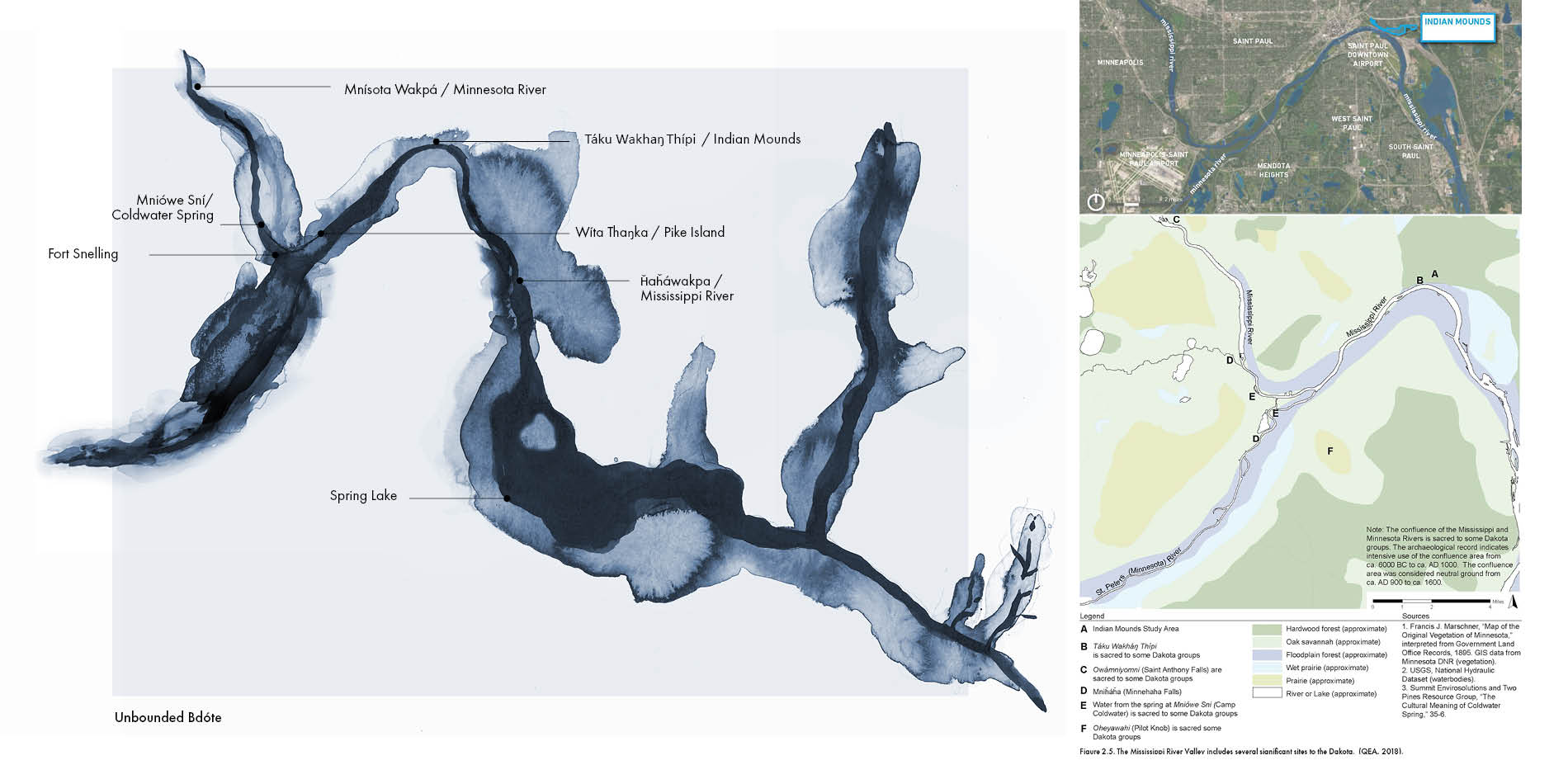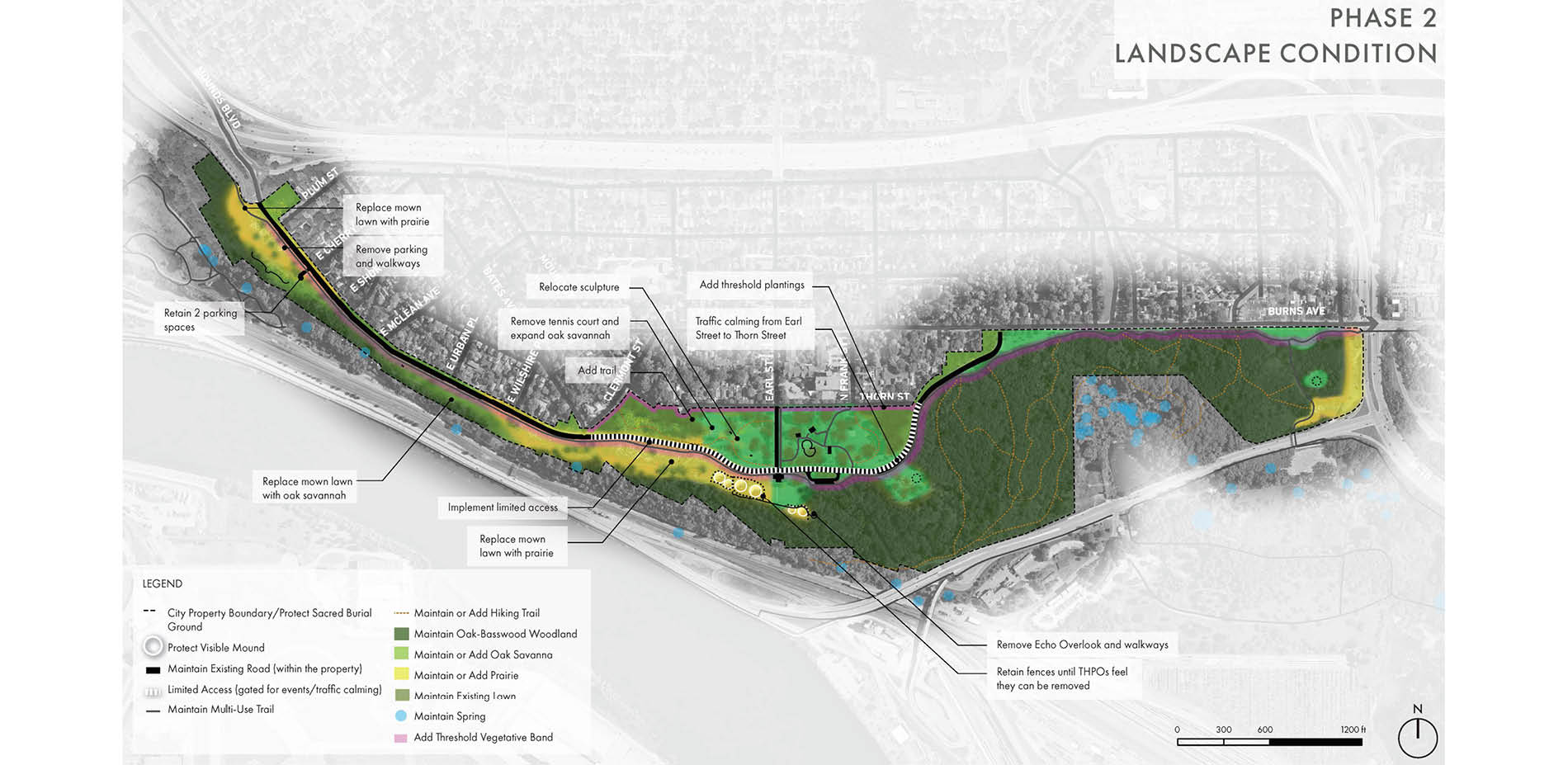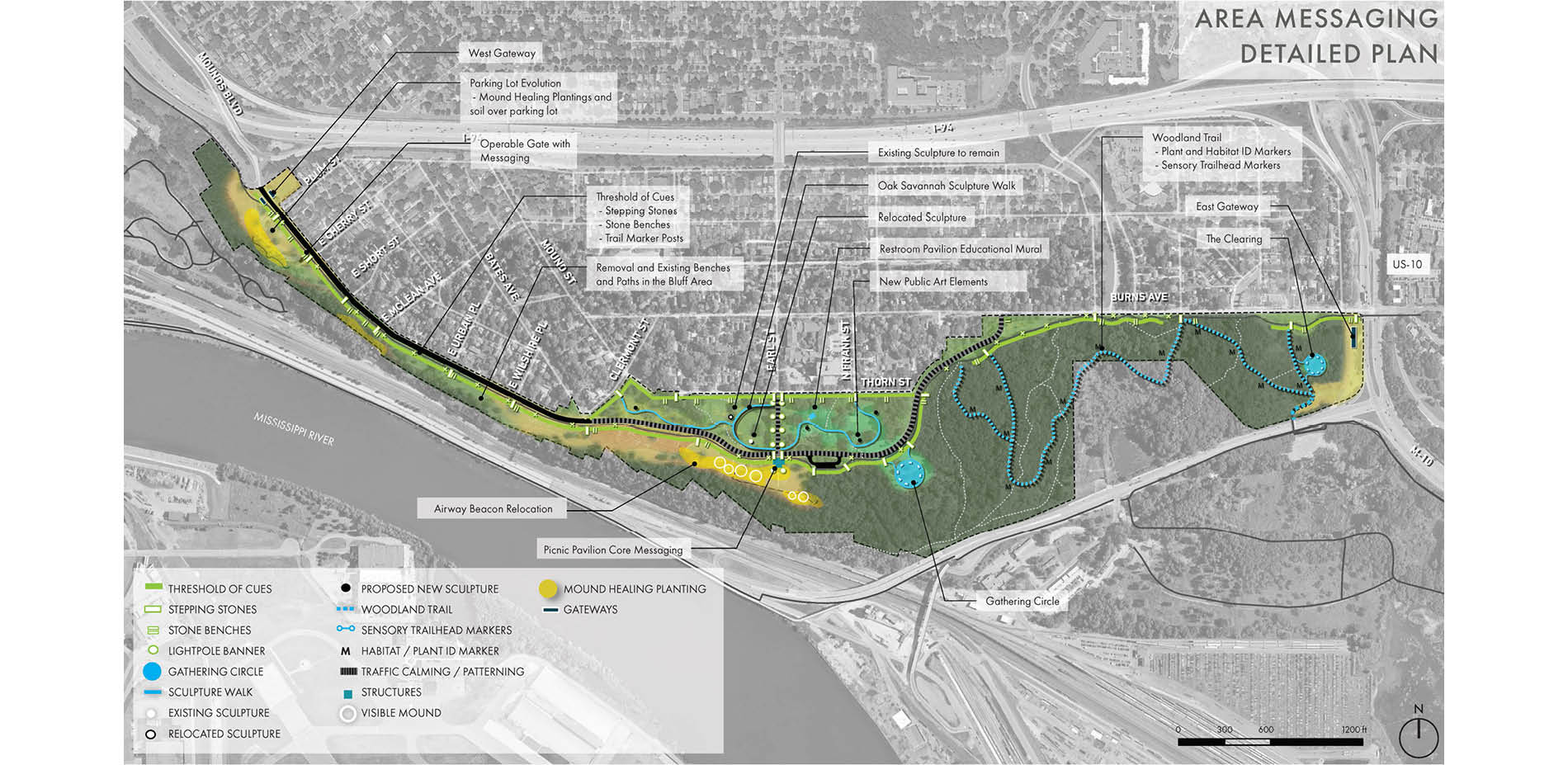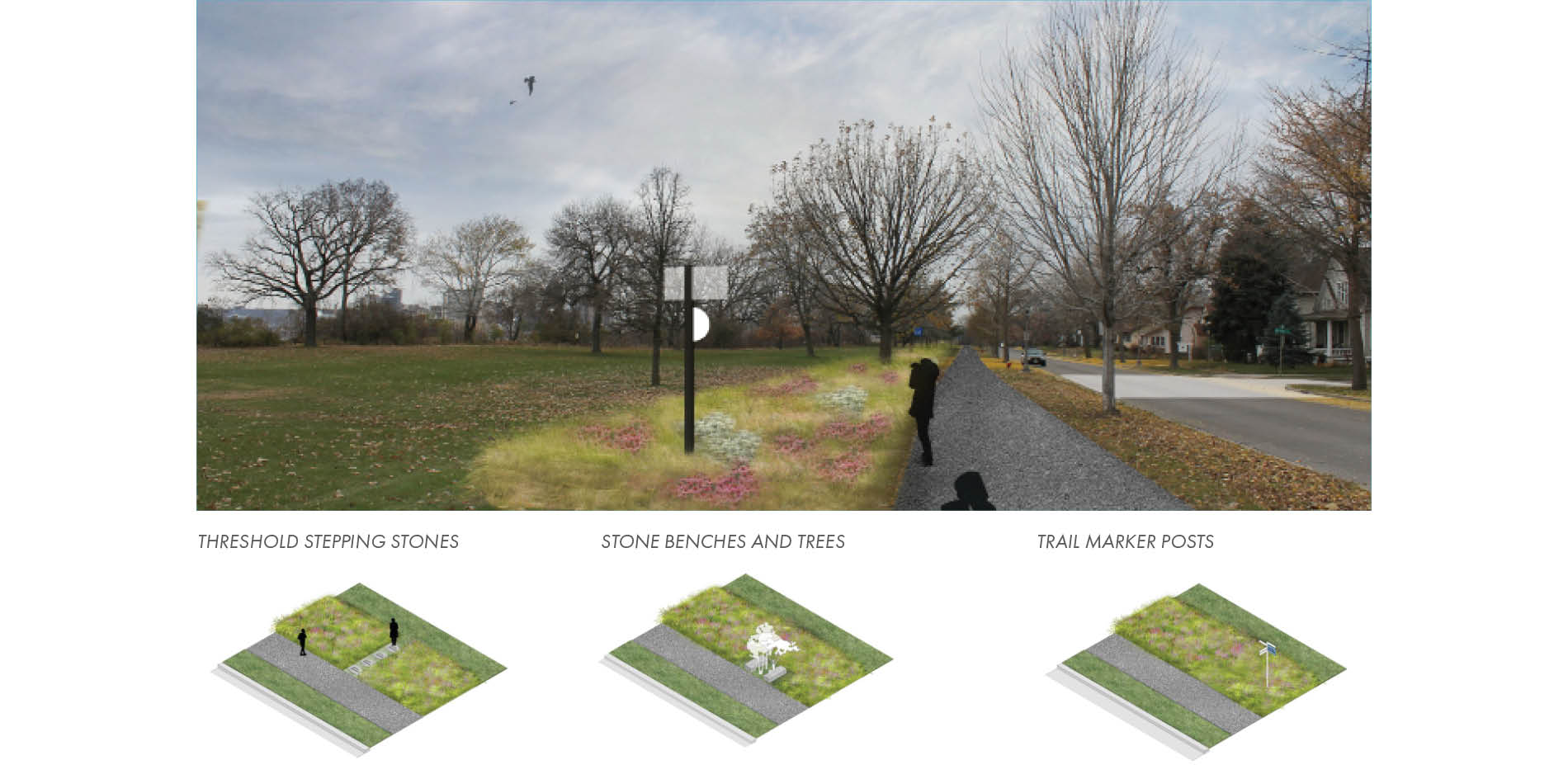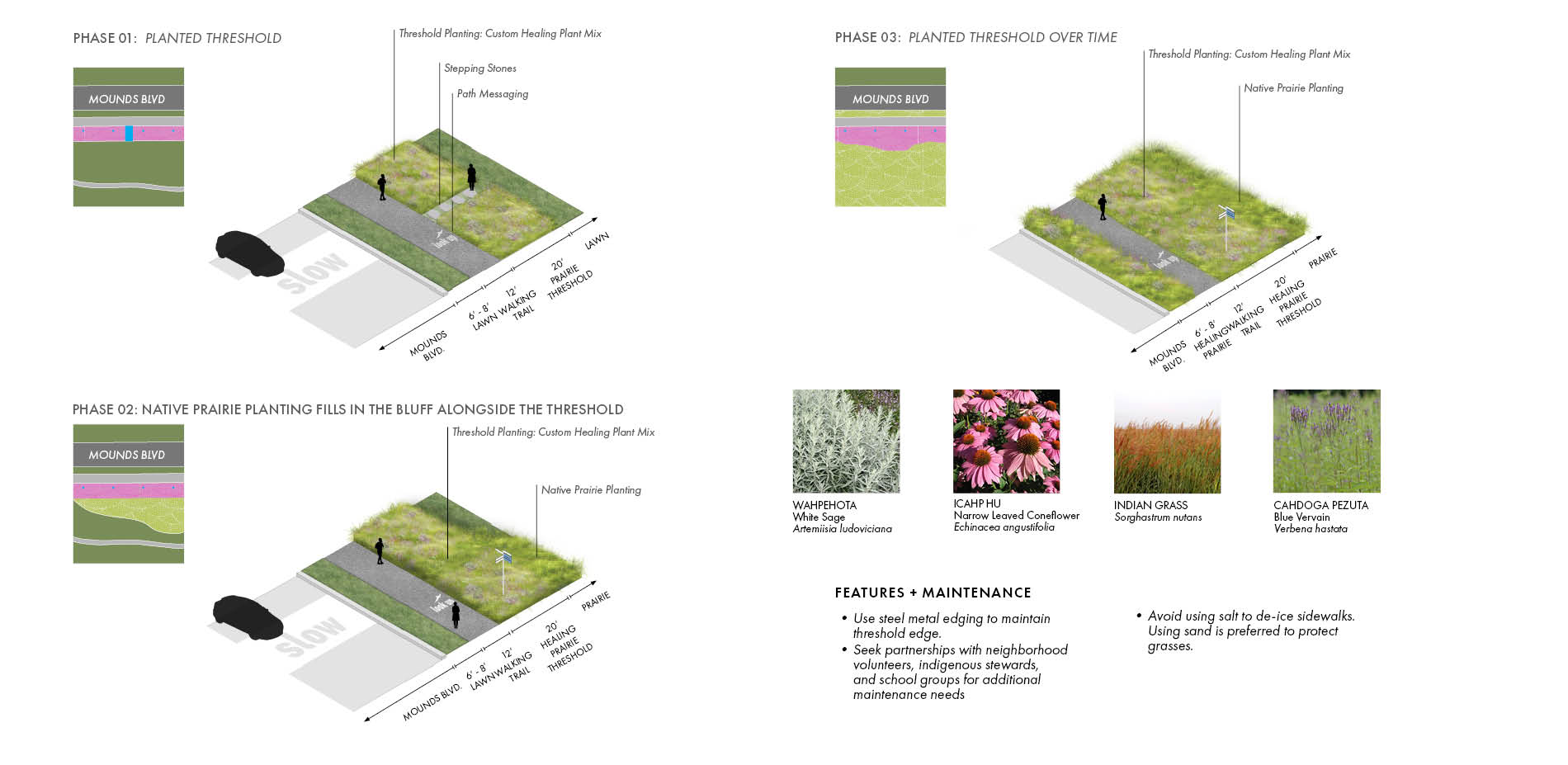Indian Mounds Cultural Landscape Study and Messaging Plan
Honor Award
Analysis and Planning
Saint Paul, Minnesota, United States
Quinn Evans
Ten x Ten
Allies, Inc.
Client: City of Saint Paul, Parks and Recreation Department
Presented with the challenge of re-framing what had become a St. Paul, Minn., public park as a sacred place, the landscape architects were also tasked with determining sensitive messaging of the site’s cultural weight and legacy to the public via onsite signage with digital complements. Tribal representatives and city staff brought in landscape architects with an eye toward preserving ancient burial grounds and reclaiming the site as a place of reverence, not recreation. By removing pavement and contemporary additions to the land and reestablishing native plants, water systems, and habitats, the landscape architects aim to restore the land to its previous sacred state with a reinforced reverence from those who visit.
- 2021 Awards Jury
Project Credits
Ten x Ten (team included Maura Rockcastle, ASLA, Katie Kelly, ASLA), Consulting Team
Allies LLC, Mona M. Smith, Consulting Team
Sisseton-Wahpeton Dakota, Media artist
Prairie Island Indian Community (Franky Jackson, compliance officer; Noah White, THPO), Tribal representatives
Shakopee Mdewakanton Sioux Community (Leonard Wabasha, Director of Cultural Resources), Tribal representatives
Upper Sioux Indian Community (Samatha Odegard, THPO), Tribal representatives
Lower Siouix Indian Community (Cheyanne St.John, THPO), Tribal representatives
Quinn Evans (team included Brenda Williams, FASLA, Stephanie Austin, ASLA, Shelby Scharen, ASLA), Landscape Architect of Record/Firm
The Ho-Chunk Nation of Wisconsin (William Quackenbush, THPO), Tribal representative
The Iowa Tribe of Kansas and Nebraska, Lance Foster (THPO)
Project Statement
Landscape Architects collaborated with tribal representatives and city staff on a plan addressing the difficult and thought-provoking challenge: How can we change a community’s perception of this landscape—an indigenous place of burial drastically altered over the last two centuries to function as a public park – toward a perspective that is informed, empathetic, and respectful of its sacredness to Indigenous Peoples? The project is an initial step to update the City’s practice for preservation, awareness, and understanding of sites significant to American Indians. The interdisciplinary team conducted rigorous research to provide a basis for a shared understanding among diverse project participants. The resulting Cultural Landscape Study presents a comprehensive framework for acknowledging the sacred site and the living Indigenous People whose ancestors are buried there while protecting, preserving and emphasizing the unique heritage of the location; strengthening appreciation of American Indian heritage; improving environmental sustainability and resilience to climate change; reducing carbon footprint; and fostering understanding through physical transformation of, and messaging within, the landscape.
Project Narrative
INTRODUCTION
The Cultural Landscape Study and Messaging Plan presents an inspirational and holistic guide to gradually replace recreational features and activities with preservation of the burial ground, expansion of native plants, messaging acknowledging the sacred site, and removal of impacting elements. The transformed landscape will support use for contemplation, prayer, and connections, for people to whom it is sacred. Landscape interventions and messaging strategies were created through an iterative and collaborative process with the Tribal Historic Preservation Officers (THPOs), the Project Advisory Team (PAT), the community, and the City of St. Paul Parks and Recreation Department. Direct engagement and consultation with the THPOs from the Upper Sioux Community, Lower Sioux Community, Shakopee Mdewakanton Sioux, Prairie Island Indian Community, and The Ho-Chunk Nation of Wisconsin, the Iowa Tribe of Kansas and Nebraska, and the Sisseton-Wahpeton Oyate—was essential to the process.
The project
1. Establishes a platform for inclusion of Indigenous communities in decision-making about sites that are significant to them.
2. Documents the historic development and use of the landscape and conducted thorough site analysis and assessment of historic significance and integrity.
3. Recommends long-term condition of the landscape informed by guidance from associated Indigenous communities.
4. Presents messaging strategies to acknowledge and help people understand this is a sacred place of burial.
THIS PLACE IS NOT A PARK
The Indigenous burial ground that is currently called “Indian Mounds Regional Park” has been a sacred burial ground for over a thousand years. It is significant to living Indigenous Peoples as a cemetery where their ancestors are buried. It is a place of reverence, remembrance, respect, and prayer. When the City of Saint Paul established a park in this location in 1892 with the purpose of protecting the historical setting and spectacular views, connections of contemporaneous Indigenous Peoples to the sacred site were not understood, considered, or valued.
Over the last century the condition, name, and use of the landscape as a park have become beloved to the surrounding community. Yet many non-Indigenous people have wondered about this powerful landscape without understanding its importance to tribes. Through public gatherings with generous sharing by tribal representatives and members of the public, we learned that the power of this place affects the people who interact with it, and there is a strong desire to protect it as a sacred site.
CULTURAL LANDSCAPE APPROACH
The Landscape Architects applied a cultural landscape approach to the study. This began by facilitating a collaborative process including diverse stakeholders to develop a vision and goals for the project. We paid careful attention to building a strong relationship between the people culturally connected to the landscape and the city who maintains it. We listened to the people whose passionate connections to this place provide the basis of its significance; and to the landscape itself that exudes a spiritual sense of place. The sacredness of this place is communicated through a variety of changes to the landscape and sharing of messages that aim to build respect and restore dignity.
Historical research utilized primary and secondary sources to develop a rich account of physical change in the landscape beginning with its geological formation through its current condition. The report includes a detailed chapter recounting the history of the site, with diagrams illustrating landscape conditions at key time periods. The tradition of mound building in Minnesota was initiated during a time when people became less mobile and larger communities came together to live in semi-permanent camps. People continued hunting and gathering and supplemented this with harvesting wild rice and gardening more intensively. Burial mounds were often located on elevated bluffs near major bodies of water, while villages were often located to provide access to wild rice. The Mississippi River valley was a regional center where people came together for ceremonies and events to reinforce communal ties and forge alliances.
Interviews and collaboration with descendant American Indians contributed a broad understanding of the meaning of the landscape to their communities today. Representatives of the associated communities were included throughout the project process to ensure their cultural perspectives informed recommendations.
A thorough analysis of integrity was conducted based on federal guidelines for cultural landscapes. The site is part of Mni Sota Makoce, Dakota homeland, and Bdote, the area surrounding the confluence of the Mississippi and Minnesota Rivers that is significant to many Dakota people as a place of origination, where the Dakota emerged. Dakota individuals come to the site to pray.
The VISION for acknowledgement, care, and use of the site, is informed by, and respectful of, it as a sacred place. The VISION is guided by Mitákuye Ows’in, reflecting the interconnectedness of people, land, water, sky, animals, and plants, to provide a place for reverence, remembrance, and healing in a way that protects, honors, and acknowledges the sacred place of burial. Goals focus on protection of the sacred site; identification and preservation or restoration of important characteristics; guidance toward the desired condition of the mounds; increased understanding and respect of the sacred burial ground, relatives, and ancestors who are here; identification of appropriate experiences; and establishment of a partnership between the city and tribes to guide use and care of the site.
TREATMENT + MESSAGING
The treatment identifies strategies addressing partnership, experience, messaging, and condition, to ensure that the Vision is consistently applied across the site. The integration of native and culturally significant plants, physical messaging cues, benches, artful interventions, and signage are designed to bring deeper understanding of the place.
Three phases build toward the long-term vision for the landscape and relationships associated with it. Each phase establishes changes to the physical landscape, strengthens relationships, and conveys the message that “this is a sacred burial ground,” through a stepped approach to build understanding of the sacred site and inspire people who come here to behave with respect. Recommendations for each part of the site address care of places of burial, natural resource management, and facilities and operations. Key to the transformation of the landscape are the establishment of a threshold of native plants and messaging cues to acknowledge the sacred site, conversion of mown areas to native plant communities, removal of impactful elements, and reduction of pavement and vehicular access.
The Messaging Plan presents Key Messages of Respect + Honor, Mitákuye Ows’in, Dakota Land, Power of Place, Geologic Time, and Ecosystems of Imnizska, to build a better understanding of this site. The messages are integrated into the landscape in a variety of ways (sculptural features, signs, paving interventions, cultural and native plantings, media, furniture and material changes) and help connect people to stories, sensory experiences, and new perspectives, embracing a world view where edges, hard lines and delineations do not exist, helping to dissolve the idea that the place of burial ends where the neighborhood begins. They are a reminder that this is not a park, it is a sacred place. Site-wide Messaging is delivered through three strategies – Immediate Acknowledgment, a Threshold of Cues, and Digital Media.
Immediate Acknowledgment is underway and includes signage across the site and digital media tied to signage, with recordings of Dakota people telling stories about the significance of this land. The City of Saint Paul is forming a partnership with the tribes to guide future decision making. The City and tribes have indicated the project has great value to direct the future of the landscape and has been a successful first step in bringing together tribal representatives and city staff in development of an appropriate vision for the future of the site.
A critical value of the project is in forging a path forward for the transformation of the landscape from a recreational site to a place of acknowledgement and respect for the Indigenous People buried there, as well as their living descendants.
Plant List
- American Elm Ulmus americana
- Basswood Tilia americana
- Bur Oak Quercus macrocarpa
- Paper Birch Betula papyrifera
- Chokecherry Prunus virginiana
- Jack in the Pulpit Arisaema triphyllum
- Meadow Rue Thalictrum dioicum
- Strawberry Fragaria virginiana
- Eastern Red Cedar Juniperus virginiana
- Northern Pin Oak Quercus ellipsoidalis
- Little Bluestem Schizachyrium scoparium
- Smooth Sumac Rhus glabra
- Common Milkweed Asclepias syriaca sub tuberosa
- Big Bluestem Andropogon gerardii
- Pussytoes Antennaria spp.
- Wild Bergamot Monarda Fistulosa
- Big Bluestem Andropogon gerardii
- Indian Grass Sorghastrum nutans
- BLUE VERVAIN Verbena hastata
- WHITE SAGE Artemiisia ludoviciana
- NARROW LEAVED CONEFLOWER Echinacea angustifolia
- Purple Prairie Clover Dalea purpurea
- Wild Bergamot Monarda fistulosa
- Meadow Blazing Star Liatris pycnostachya
- New England Aster Symphyotrichum novae-angliae
- Switchgrass Panicum virgatum

